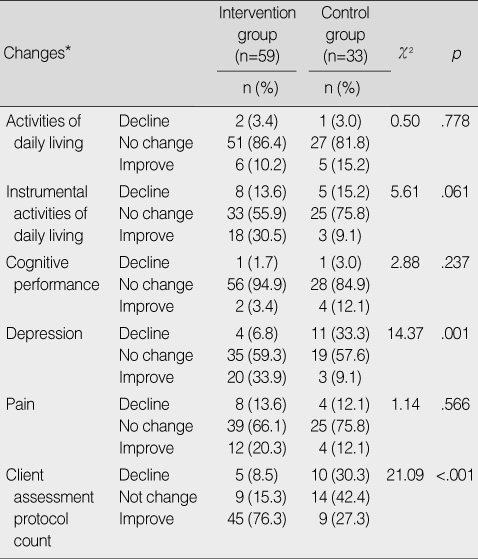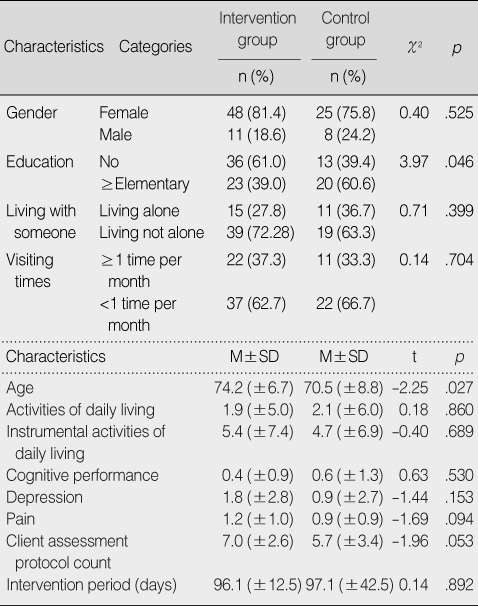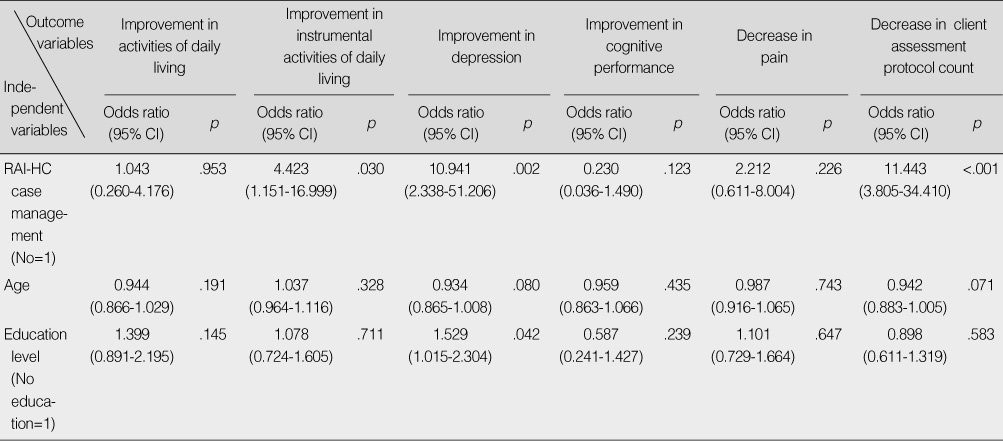Articles
- Page Path
- HOME > J Korean Acad Nurs > Volume 39(3); 2009 > Article
-
Original Article
- Effects of Case Management using Resident Assessment Instrument-Home Care (RAI-HC) in Home Health Services for Older People
- Kyung Ja June, Ji Yun Lee, Jong Lull Yoon
-
Journal of Korean Academy of Nursing 2009;39(3):366-375.
DOI: https://doi.org/10.4040/jkan.2009.39.3.366
Published online: June 29, 2009
1Professor, Department of Nursing, Soonchunhyang University, Cheonan, Korea.
2Full-time Lecturer, Department of Nursing, Hoseo University, Asan, Korea.
3Professor, Department of Family Medicine, Hallym University Medical Center, Seoul, Korea.
- Address reprint requests to: Lee, Ji Yun. Department of Nursing, Hoseo University, 165 Sechul-ri, Baebang-myeon, Asan 336-795, Korea. Tel: 82-41-540-9534, Fax: 82-41-540-9558, leejiyun@hoseo.edu
Copyright © 2009 Korean Society of Nursing Science
Abstract
-
Purpose
- To evaluate the effects of case management using Resident Assessment Instrument-Home Care (RAI-HC) in home health service for older people.
-
Methods
- All elders were assessed at baseline and 3 months later using RAI-HC. The change of function in the intervention group was compared with that of a conventional intervention group. Function was measured with Activities of Daily Living (ADL), Instrumental Activities of Daily Living (IADL), Cognitive Performance Scale (CPS), Depression Rating Scale (DRS), Pain and the number of Clinical Assessment Protocols (CAP).
-
Results
- Among ninety two elders participated in the program, 59 were allocated to the case management group and 33 to the conventional group. The intervention, home health service by a nurse over a 3 month period, consisted of comprehensive assessment, case conference for care plan, direct care, education and referral, and outcome evaluation. The percent of elders whose function improved in the intervention group was greater than the conventional group for depression (odds ratio [OR]: 10.941, confidence interval [CI]: 2.338-51.206), IADL (OR: 4.423, CI: 1.151-16.999) and the number of CAP (OR: 11.443, CI: 3.805-34.410).
-
Conclusion
- Case management was effective for older people in the community. The effect might have resulted from individual, systematic intervention, however, standards of service including eligibility criteria for case management and collaboration of multi-disciplines is required for more effective home health service programs.
- 1. Bernabei R, Landi F, Gambassi G, Sgadari A, Zuccala G, Mor V, et al. Randomised trial of impact of model of integrated care and case management for older people living in the community. British Medical Journal. 1998;316:1348–1351.ArticlePMC
- 2. Burrows AB, Morris JN, Simon SE, Hidres JP, Phillips C. Development of a minimum data set-Based depression rating scale for use in nursing homes. Age and Ageing. 2000;29:165–172.ArticlePubMed
- 3. Carpenter GI, Demopoulos GR. Screening the elderly in the community: Controlled trial of dependency surveillance using a questionnaire administered by volunteers. British Medical Journal. 1990;300:1253–1256.ArticlePubMedPMC
- 4. Fries BE, Simon SE, Morris JN, Flodstrom C, Bookstein F.L. Pain in US nursing homes: Validating a pain scale for Minimum Data Set. Gerontology. 2001;41:173–179.
- 5. Hallberg IR, Kristensson J. Preventive home care of frail older people: A review of recent case management studies. Journal of Clinical Nursing. 2004;13(6b):112–120.ArticlePubMed
- 6. Hamilton M. Development of a rating scale for primary depressive illness. The British Journal of Social and Clinical Psychology. 1967;6:278–296.ArticlePubMed
- 7. Hartmaier SL, Sloane PD, Guess HA, Koch GG, Mitchell CM, Phillips CD. Validation of the minimum data set cognitive performance scale: Agreement with the Mini-Mental State Examination. Journal of Gerontology. Series A, Biological Science and Medical Sciences. 1995;50:M128–M133.
- 8. Health insurance review statistics. Health Insurance Review and Assessment Service & National Health Insurance Corporation. 2007;Retrived June 12, 2008. from http://www.hira.or.kr/common/dummy.jsp?pgmid=HIRAF010303000000.
- 9. Hendriksen C, Lund E, Stromgard E. Consequences of assessment and intervention among elderly people: A three-year randomized controlled trial. British Medical Journal. 1984;289:1522–1524.PubMedPMC
- 10. June KJ, Cho YM. A survey on functional status among low income older adults living at home. Journal of Korean Academy of Nursing. 2001;31:749–758.ArticlePDF
- 11. Katz S, Ford AB, Moskowitz RW, Jackson BA, Jaffe MA. Studies of illness in the aged. The index of ADL: A standardized measure of biological and psychological function. The Journal of the American Medical Association. 1963;185:914–919.PubMed
- 12. Kim EK, Park HY, Kim C.Y. On the feasibility of a RUG-III based payment system for long term care facilities in Korea. Journal of Korean Academy of Nursing. 2004;34:278–289.ArticlePubMedPDF
- 13. Kim HG. Development of case management model for the bedridden elderly at home and its evaluation: Focusing on RAI MDSHC 2.0 Application. 2001;Seoul, Chung Ang University. Unpublished doctoral dissertation.
- 14. Census of population in Korea on 2005 years. Korea National Statistical Office (KNSO). 2006;Retrieved June 12, 2008. from http://www.kosis.kr.
- 15. Lawton MP, Brady EM. Assessment of older people: Self maintaining and instrumental activities of daily living. The Gerontologist. 1969;9:179–186.ArticlePubMed
- 16. Lee SH, Kim HJ, Chang HS. Development of services delivery model for the elderly in the community. 2000;Seoul, Korea Health Industry Development Institute.
- 17. Ministry for Health and Welfare. Guideline of visiting health program for 2006. 2006;Seoul, Author.
- 18. Morris JN, Fries BE, Bernabei R, Steel K, Ikegami N, Carpenter I, et al. Kim CY Kim SM . RAI-HC Assessment manual Seoul. 2000;Washington DC, interRAI Corporation. (Original work published 1999).
- 19. Morris JN, Fries BE, Mehr DR, Phillips C, Mor V, et al. MDS Cognitive Performance Scale. Journal of Gerontology. 1994;49:M174–M182.ArticlePubMed
- 20. Morris JN, Fries BE, Morris SA. Scaling ADLs with theMDS. The Journal of Gerontology, Series A, Biological Sciences and Medical Scienc. s. 1999;54:M546–M553.
- 21. Nicolaides-Bouman A, van Rossum E, Habers H, Kempen GI. Home visiting programme for older people with health problems: Process evaluation. Journal of Advanced Nursing. 2007;58:425–435.ArticlePubMed
- 22. Phillips CD, Morris JN, Hawes C, Fries BE, Mor V, Nennstiel M, et al. Association of the Resident Assessment Instrument (RAI) with changes in function, cognition, and psychosocial status. Journal of American Geriatrics Society. 1997;45:986–993.Article
- 23. Stuck AE, Aronow HU, Steiner A. A trial of annual comprehensive geriatric assessments for elderly people living in the community. New England Journal of Medicine. 1995;333:1184–1189.PubMed
- 24. Theander E, Edberg AK. Preventive home visits to older people in Southern Sweden. Scandinavian Journal of Public Health. 2005;33:392–400.ArticlePubMedPDF
- 25. Thome B, Dykes A, Hallberg IR. Home care with regard to definition, care recipients, content and outcome: Systematic literature review. Journal of Clinical Nursing. 2003;12:860–872.ArticlePubMed
- 26. van Rossum E, Fredericks C, Phillips H, Portengen K, Wiskerke J, Knipschild P. Effects of preventive home visits to elderly people. British Medical Journal. 1993;307:27–32.ArticlePubMedPMC
- 27. Yi GM, Kim HJ. Depression and anxiety in community-dwelling older persons of Korea. Journal of the Korean Gerontological Society. 2000;20:109–121.
- 28. Yoon JY. The effect of case management for the frail elderly at home. 2006;Seoul, Seoul National University. Unpublished master's thesis.
- 29. Zander K. Nursing case management in the 21st Century: Intervening where margin meets mission. Nursing Administration Quarterly. 2002;26(5):58–67.ArticlePubMed
REFERENCES

*"Decline" means that score of ADL, IADL, cognitive performance scale, depression rating scale, pain scale and the number of CAPs increased from baseline to follow-up; "Improve" means that score of ADL, IADL, cognitive performance scale, depression rating scale, pain scale and the number of CAPs decreased.
Figure & Data
REFERENCES
Citations

- Examining Utilization of Formal Supports and Related Impacts on Overall Well-Being Among East Asian American Family Caregivers of Persons With Dementia: A Mixed-Methods Study
Kathy Lee, Jessica Cassidy, Jihui Lee, Chang Hyun Seo, Alan Kunz Lomelin, Hye-Won Shin, Joshua D Grill, Tonya J Roberts
The Gerontologist.2024;[Epub] CrossRef - Case management for integrated care of older people with frailty in community settings
Euan Sadler, Zarnie Khadjesari, Alexandra Ziemann, Katie J Sheehan, Julie Whitney, Dan Wilson, Ioannis Bakolis, Nick Sevdalis, Jane Sandall, Tayana Soukup, Teresa Corbett, Daniela C Gonçalves-Bradley, Dawn-Marie Walker
Cochrane Database of Systematic Reviews.2023;[Epub] CrossRef - Development and testing of the Geriatric Care Assessment Practices (G-CAP) survey
Justine L. Giosa, Paul Stolee, Paul Holyoke
BMC Geriatrics.2021;[Epub] CrossRef - Social Support, Activities of Daily Living, and Depression among Older Japanese and Koreans Immigrants in the U.S
Bumjung Kim, Hyeyoun Jun, Jisun Lee, Yun Min Kim
Social Work in Public Health.2020; 35(4): 163. CrossRef - Care Tips for Self-Care among Older Diabetic Patients
Been Yoo
The Journal of Korean Diabetes.2019; 20(3): 190. CrossRef - Identifying and prioritizing topics for evidence‐based geriatric nursing practice guidelines in Korea
S. Kim, K. Kim, S. J. Kim
International Nursing Review.2018; 65(4): 550. CrossRef - Risk and protective factors associated with intentional self‐harm among older community‐residing home care clients in Ontario, Canada
Eva Neufeld, John P. Hirdes, Christopher M. Perlman, Terry Rabinowitz
International Journal of Geriatric Psychiatry.2015; 30(10): 1032. CrossRef - Current Status and Barriers to Health Care Services for Nursing Home Residents: Perspectives of Staffs in Korean Nursing Homes
Yeon-Hwan Park, Hwal Lan Bang, Ga Hye Kim, Seieun Oh, Young-Il Jung, Hongsoo Kim
Korean Journal of Adult Nursing.2015; 27(4): 418. CrossRef - Improving health status and reduction of institutionalization in long‐term care—Effects of the Resident Assessment Instrument‐Home Care by degree of implementation
Claudia Stolle, Annika Wolter, Günter Roth, Heinz Rothgang
International Journal of Nursing Practice.2015; 21(5): 612. CrossRef - The Relationship Between Activities of Daily Living (ADL), Chronic Diseases, and Depression Among Older Korean Immigrants
Bum Jung Kim, Young Choi
Educational Gerontology.2015; 41(6): 417. CrossRef - Home Visits for Prevention of Impairment and Death in Older Adults: A Systematic Review
Sean Grant, Amanda Parsons, Jennifer Burton, Paul Montgomery, Kristen Underhill, Evan Mayo Wilson
Campbell Systematic Reviews.2014; 10(1): 1. CrossRef - RAI-HC as an innovative tool for future practice in home care
Helena Kisvetrová, Yukari Yamada
Journal of Nursing, Social Studies, Public Health and Rehabilitation.2014; 5(1-2): 16. CrossRef - Preventive Home Visits for Mortality, Morbidity, and Institutionalization in Older Adults: A Systematic Review and Meta-Analysis
Evan Mayo-Wilson, Sean Grant, Jennifer Burton, Amanda Parsons, Kristen Underhill, Paul Montgomery, Hemachandra Reddy
PLoS ONE.2014; 9(3): e89257. CrossRef - Structural Equation Modeling on Case Management Outcomes and Factors Influencing Outcomes in the Community-dwelling Vulnerable Elders
Hyunjung Moon, In-Sook Lee
Journal of Korean Academy of Nursing.2013; 43(6): 791. CrossRef - Effects of the Resident Assessment Instrument in home care settings
C. Stolle, A. Wolter, G. Roth, H. Rothgang
Zeitschrift für Gerontologie und Geriatrie.2012; 45(4): 315. CrossRef - Developing a Comprehensive Geriatric Assessment Package for Successful Aging
Seon-Ho Kim, Doo-Nam Oh
The Journal of the Korea Contents Association.2012; 12(9): 257. CrossRef - The Effects of Case Management for Clients with Clonorchiasis in Riverside Areas
Chunmi Kim, Hee-Gerl Kim, Kyung-Ja June, Souk-Young Kim
Journal of Korean Academy of Community Health Nursing.2012; 23(4): 427. CrossRef - Effects of Tailored Case Management using a Gatekeeper for the Depressed Single-household Elderly Population -Focusing on the Mental Health Case Management-
Yun-Jung Choi, Mi-Ra Won
Journal of Korean Academy of Community Health Nursing.2012; 23(4): 376. CrossRef - The Effects of a Case Management Program of Customized Home Visiting Health Service for Clients with Arthritis
Soon-Ok Yang, Myung Soon Kwon, Yong-Jun Choi, Seung-Hee Lee
Journal of Korean Academy of Community Health Nursing.2011; 22(2): 151. CrossRef - Health Needs of the Elderly in Long-term Care Facilities: Using RAI-MDS-FC
Eun-Joo Bang, Soon-Young Yun
Journal of Korean Academy of Community Health Nursing.2010; 21(2): 263. CrossRef - The Comparison of Functional Status and the Level of Health Care Needs in Elderly Koreans in Health Care Institutions
Hyun-Sil Kim, Young-Mi Jung, Hung-Sa Lee, Yoo-Hyang Cho, In-Young Yoo
Journal of Korean Academy of Community Health Nursing.2010; 21(4): 386. CrossRef
Homogeneity of Baseline Characteristics of Elders between Intervention and Control group
Comparison of Outcomes between Intervention and Control group
*"Decline" means that score of ADL, IADL, cognitive performance scale, depression rating scale, pain scale and the number of CAPs increased from baseline to follow-up; "Improve" means that score of ADL, IADL, cognitive performance scale, depression rating scale, pain scale and the number of CAPs decreased.
Impact of RAI-HC Case Management on Improvement of Function
RAI-HC=resident assessment instrument-home care; CI=confidence interval.
*"Decline" means that score of ADL, IADL, cognitive performance scale, depression rating scale, pain scale and the number of CAPs increased from baseline to follow-up; "Improve" means that score of ADL, IADL, cognitive performance scale, depression rating scale, pain scale and the number of CAPs decreased.
RAI-HC=resident assessment instrument-home care; CI=confidence interval.
 KSNS
KSNS
 E-SUBMISSION
E-SUBMISSION


 Cite
Cite

